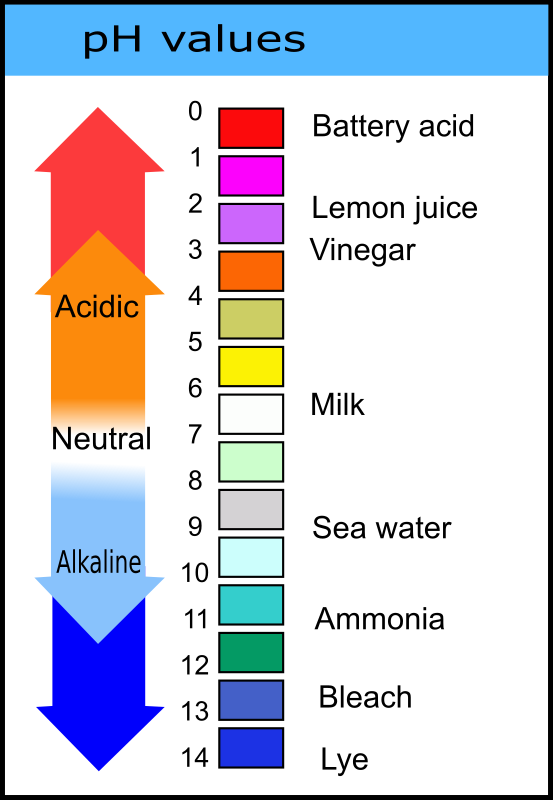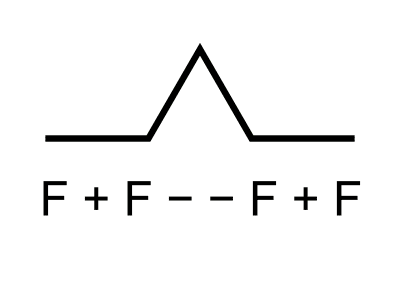Introduction

pH Scale
Public Domain: https://openclipart.org/detail/302548/ph-values-chart
In science, chemistry especially, scientists tend to work with many different chemicals. In order to understand how acidic a substance is, these chemicals are measured with something known as a pH scale.
The pH of a substance can either be measured using a pH meter which gives a numerical value, or it can be measured using an indicator and comparing the colour with a pH scale.
The pH scale
- The pH scale is a number scale usually from 0 to 14. It tells us how acidic or alkaline an aqueous solution is.
- An aqueous solution is a solution that is made by dissolving a substance into water.
- You can either classify a solution as acidic, neutral or alkaline depending on which part of the scale it ends up on.
- Solutions that are neutral have a pH of 7,
- Solutions that have pH values less than 7 are known as acidic. The smaller the value is, the more acidic it is,
- Solutions that have pH values more than 7 are known as alkaline. The larger the value is, the more alkaline it is.
Universal indicator is some substance that reacts with the pH. You can find many universal indicators from the nature (eg. red cabbage juice). The patent of the commercial universal indicator originates from year 1933.
The universal indicator can show us how strongly acidic or alkaline a solution is accurately using a pH scale. Universal indicator has many different colour changes ranging from red for acids, green for neutral and blue/purple for alkaline. Also, there exists electronic devices to measure pH. See the Arduino pH meter given in the links, https://create.arduino.cc/projecthub/atlasscientific/arduino-ph-meter-e94fb4.
Task

Logo graphics
Public Domain: https://upload.wikimedia.org/wikipedia/commons/0/09/KochTurtleAnim.gif
The exercise is multidimensional and very cross curriculum. You'll learn to draw images using Python, but the drawing method is something called LOGO programming. LOGO was originally a robot that draws on a big paper -- however, using computer to create the drawings makes the lines straighter and neater. Of course, the colors can be changed and you can paint regions. Using LOGO graphics you can draw any image you wish. In Python the LOGO is called Turtle. You can check Online LOGO (https://www.transum.org/software/Logo/) for more ideas about LOGO drawing, or the video Python Turtle Tutorial - Code Your First Game! about how to create a game using LOGO graphics.
Other thing to learn is pH scale (see Wikipedia: https://en.wikipedia.org/wiki/PH) and acidity or alkaline. Which materials are acid, which are alkaline. How about neutral solutions? See the link https://www.thespruce.com/ph-levels-for-common-cleaning-supplies-1900473 for more information How color is related to pH? Furthermore, you might consider how pH is related to hydrogen ions! Can you make indicator paper at home?
How to define a color? What is a color? In computer science colours are often defined using three numbers, one for red, one for green ja one for blue. For example black is 0 0 0, red is 255 0 0, green is 0 255 0 and white is 255 255 255. Some colors and their names are given at pages 12-13 of level 1 pH scale.pdf document and the RGB explained is in 30 seconds in the video given in links.
Page 33 of the document shows some materials and their pH. Can you find those items at your household? Can you explain why baking soda is so good at removing coffee stains? At home, you can test mixing baking soda and vinegar, or just watch the video Vinegar + Baking Soda + Balloons = FIZZY FUN! | Kids Science Experiments | Science for Kids. What happens? Why? pH is also related to other topic in this course, namely the Water cycle. Why water is acid? If the acidity level of seas rises, what is the effect for sea shells or corals (watch the video Ocean Acidification)? See the Link Average pH Levels of Common Cleaning Supplies to find out more about cleaning and pH.
Below is an image about the pH scale we are going to create.
* Advanced task: Find a substance whose pH is larger than 14. Which substance has a pH smaller than 0? See the link https://www.sciencefocus.com/science/could-a-ph-greater-than-14-exist/
* Advanced: Lower case p in pH means 10 base logarithm, and upper case H means the density of hydrogen ions.
Process
First, open Python: https://trinket.io/turtle
- See the pages 7-9 about Python libraries. Python is multifunctional programming languages, and collection of different coding blocks (or functions) is called a Library. The amount of possible Python libraries is huge.
- Create our own functions, or subroutines. This is described at page 11.
- Add more functions to draw rectangles of different colors as described in Steps 3 to 18 (14-29). You can easily copy/paste and edit those functions using the one you created on the previous step. Note that only the color changes. At advanced level you can create one function that takes as the input the color.
- Create the main function in Step 19 (page 30). That calls each of our functions. The lines 172 - 200 can be replaced by an array and loop, which is the advanced method.
- Extra: Online logo (given the links on the left) is a great tool to draw more using LOGO language. You can try that tool to draw images using LOGO.
Conclusion
- You are familiar with different properties, like mass, density or volume.
- This exercise introduces pH, which describes if a solution is acid or alkalic.You should be able to name acidic and alkalic solutions.
- You can draw rectangles and almost any (simple) image using Python Turtle library.
- You should know how computers describe and use colors.
Next steps:
- Create your won draing using Python Turtle library
- Move to Level 2 Python Activitity or try the Anatomy quiz activity.
Links to everyday life:
- pH is an important property of household equipment, eg. in cleaning supplies or in cooking or baking.
- Acidification of our seas is related to the climate change.
- Indicator can be a familiar substance, eg. red gabbage.
Learning Objectives
Learning Objectives
- You know what is pH and pH scale.
- You can import the python library for turtle graphics.
- You can name three things with pH less than 7.
- You can define and call subroutines.
- You can name 5 things with pH more than 7.
- You are able to understand python’s colour library and choose appropriate colour's for the pH scale.
- You know how colors are defined in computers.
- You can use for loops.
- You know how to use baking soda and vinegar in cleaning.
Resources
Click each section below to see all resources available.
Resources
Click each section below to see all resources available.








